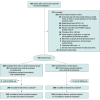Intra-Arterial Urokinase After Endovascular Reperfusion for Acute Ischemic Stroke: The POST-UK Randomized Clinical Trial
- PMID: 39804674
- PMCID: PMC11836763
- DOI: 10.1001/jama.2024.23480
Intra-Arterial Urokinase After Endovascular Reperfusion for Acute Ischemic Stroke: The POST-UK Randomized Clinical Trial
Abstract
Importance: Persisting or new thrombi in the distal arteries and the microcirculation have been reported to limit the benefits of successful endovascular thrombectomy for patients with acute ischemic stroke. It remains uncertain whether intra-arterial thrombolysis by urokinase following near-complete to complete reperfusion by thrombectomy improves outcomes among patients with ischemic stroke due to large vessel occlusion.
Objective: To assess the efficacy and adverse events of intra-arterial urokinase after near-complete to complete reperfusion by thrombectomy for acute ischemic stroke due to large vessel occlusion.
Design, setting, and participants: This investigator-initiated, randomized, open-label, blinded-end point trial was implemented at 35 hospitals in China, enrolling 535 patients with proximal intracranial large vessel occlusion presenting within 24 hours of time last known well, who achieved near-complete or complete reperfusion by endovascular thrombectomy and did not receive intravenous thrombolysis prior to the procedure. Recruitment took place between November 15, 2022, and March 29, 2024, with final follow-up on July 4, 2024.
Interventions: Eligible patients were randomly assigned to the intra-arterial urokinase group (a single dose of intra-arterial 100 000 IU urokinase injected in the initial target territory; n = 267) or control group (without intra-arterial thrombolysis; n = 267).
Main outcomes and measures: The primary efficacy outcome was the percentage of patients achieving survival without disability (modified Rankin Scale score of 0 or 1) at 90 days. The primary safety outcomes were mortality at 90 days and incidence of symptomatic intracranial hemorrhage within 48 hours.
Results: A total of 535 patients were enrolled (median age, 69 years; 223 [41.8%] female) and 532 (99.6%) completed the trial. The percentage of patients with survival without disability at 90 days was 45.1% (120/266) in the intra-arterial urokinase group and 40.2% (107/266) in the control group (adjusted risk ratio, 1.13 [95% CI, 0.94-1.36]; P = .19). Mortality at 90 days (18.4% vs 17.3%, respectively; adjusted hazard ratio, 1.06 [95% CI, 0.71-1.59]; P = .77) and incidence of symptomatic intracranial hemorrhage (4.1% vs 4.1%, respectively; adjusted risk ratio, 1.05 [95% CI, 0.45-2.44]; P = .91) were not significantly different between groups.
Conclusions and relevance: Among patients with acute ischemic stroke due to large vessel occlusion, adjunct intra-arterial urokinase after near-complete to complete reperfusion by endovascular thrombectomy did not significantly increase the likelihood of survival without disability at 90 days.
Trial registration: ChiCTR.org.cn Identifier: ChiCTR2200065617.
Conflict of interest statement
Figures



Comment in
-
Intra-Arterial Thrombolytics During Thrombectomy for Ischemic Stroke-End of the Story or a New Beginning?JAMA. 2025 Feb 18;333(7):571-573. doi: 10.1001/jama.2024.27100. JAMA. 2025. PMID: 39804672 No abstract available.
References
Publication types
MeSH terms
Substances
Associated data
LinkOut - more resources
Full Text Sources
Medical

